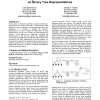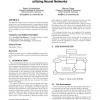122
click to vote
GECCO
2006
Springer
15 years 4 months ago
2006
Springer
In some cases, evolutionary algorithms represent individuals as typical binary trees with n leaves and n-1 internal nodes. When designing a crossover operator for a particular rep...
58
Voted
GECCO
2006
Springer
15 years 4 months ago
2006
Springer
GECCO
2006
Springer
15 years 4 months ago
2006
Springer
This work shows asymptotic convergence to global optima for a family of dynamically scaled genetic programming systems where the underlying population consists of a fixed number o...
GECCO
2006
Springer
15 years 4 months ago
2006
Springer
This paper investigates whether replacing non-modular artificial neural network brains of visual agents with modular brains improves their ability to solve difficult tasks, specif...
112
click to vote
GECCO
2006
Springer
15 years 4 months ago
2006
Springer
The purpose of this work is to propose an immune-inspired setup to use a self-organizing map as a computational model for the interaction of antigens and antibodies. The proposed ...
127
click to vote
GECCO
2006
Springer
15 years 4 months ago
2006
Springer
This paper describes our study into the concept of using rewards in a classifier system applied to the acquisition of decision-making algorithms for agents in a soccer game. Our a...
94
Voted
GECCO
2006
Springer
15 years 4 months ago
2006
Springer
The paper presents an evaluation-relaxation scheme where a fitness surrogate automatically adapts to the problem structure and the partial contributions of subsolutions to the fit...
GECCO
2006
Springer
15 years 4 months ago
2006
Springer
This paper studies the effectiveness of multiobjective genetic and evolutionary algorithms in multiscaling excited state direct dynamics in photochemistry via rapid reparameteriza...
GECCO
2006
Springer
15 years 4 months ago
2006
Springer
Learning goal-scoring behaviour from scratch for simulated robot soccer is considered to be a very difficult problem, and is often achieved by endowing players with an innate set ...
GECCO
2006
Springer
15 years 4 months ago
2006
Springer
Evolutionary algorithms tend to produce solutions that are not evolvable: Although current fitness may be high, further search is impeded as the effects of mutation and crossover ...


